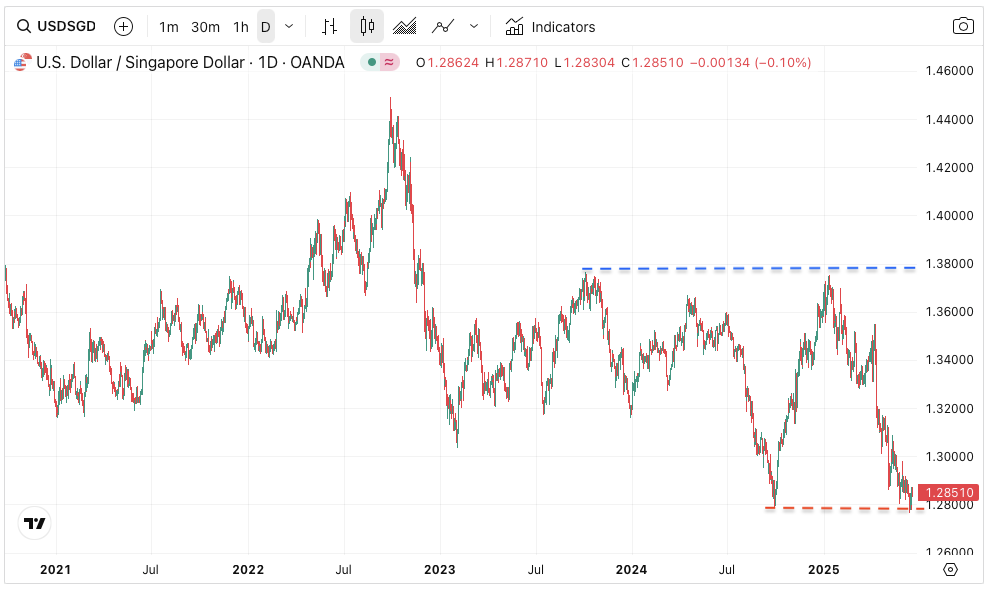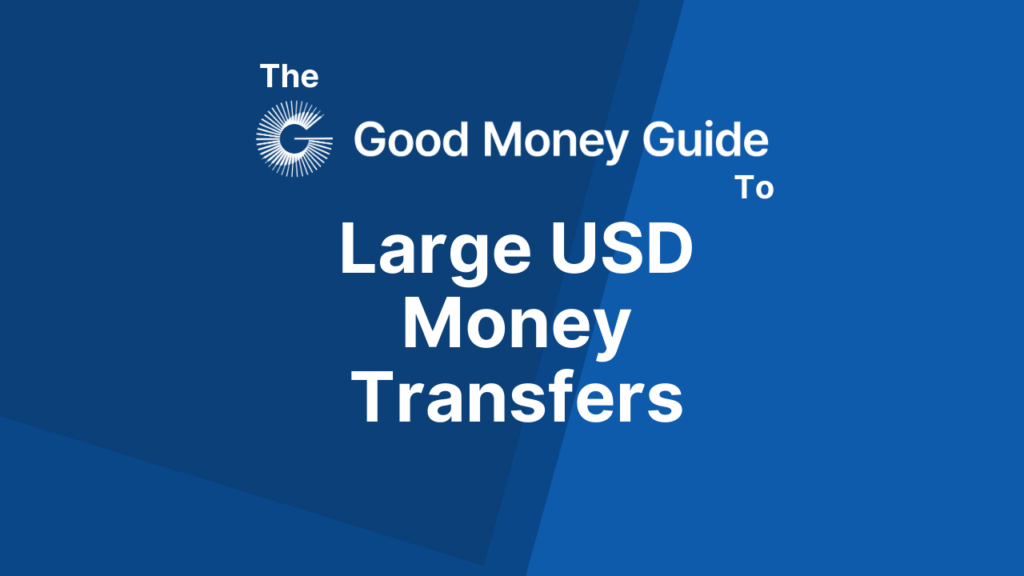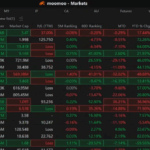USDSGD Forecast Highlights
- USDSGD regressed beneath 1.300 to retest 2024 lows
- Downward trend driven mainly by USD weakness (due to higher tariff rate)
- Macro and policy uncertainties will dictate the next trend phase
How has USDSGD performed recently?
The Singapore Dollar has been strengthening markedly against the US dollar since the start of the year.
The persistent swings in USDSGD is also out of character for the rate. Prices first slumped to 1.28 in the summer of 2024, before clawing back these losses entirely on Trump’s election win. Then, the rate plunged all the way again to 1.280 (see below). The latest fall was caused by the so-called reciprocal tariffs and a weakening of US economic forecasts. This led to a devaluation of USD across the board.
These multi-month swings affirms the technical bands along the previous pivot points (1.380 to the north; 1.280 at the bottom).
What now? Will the 1.280 floor give way, or will we see another swing upwards back above 1.300? Earlier in the year, few expected USDSGD to crash this badly (USD weaker). The new – and higher – global tariff rate was totally unexpected. As we are still within the 90-day pause to the US higher tariff rates, traders have continued to sell into any USD bounce.
At this point, USD bears would be tempted to test if the support at 1.280 holds. Any near-term volatility may send the rate south of this floor.

Is it a good time to buy US dollars?
If you need USD in the near term, 1.2800 is a very good rate to buy some US dollars with SGD.
The last time USDSGD was trading at these levels was September 2024. The latest volatility has given SGD holders another chance to lock in this excellent rate.
Of course, the rate could drop further into multi-year lows. But this is by no means guaranteed. The trend is oversold and trading at prior pivot lows. A deal between US and China may propel USD higher.
Therefore, watch to buy some USDs now and watch to buy more on a further drop.
Will SGD get stronger against USD?
In Singapore, the currency is a closely monitored instrument. This is because the monetary authority (mas.gov.sg) targets the country’s currency in order to control local price stability.
The intermediate target is called the Singapore Dollar Nominal Effective Exchange Rate (S$NEER), a trade-weighted basket of currencies. This is markedly different to, say, the United Kingdom where the Bank of England employs the Base Rate as a broad instrument to stabilise prices. Simply, the monetary authority does not fix or peg the Singapore Dollar against any one currency. It uses a trade-weighted basket to judge the effective strength of SGD and then manages this basket broadly. It allow day-to-day price fluctuation of individual exchange rates.
The reason for this (as clearly articulated here) is that Singapore is a small and open economy. Its “gross exports and imports of goods and services are more than 300 percent of GDP and domestic expenditure has a high import content, the exchange rate has a much stronger influence on inflation than the interest rate.”
The most recent chart of S$NEER is plotted below:

Source: mas.gov.sg (Apr 2025)
Essentially, there are three parameters to this S$NEER: slope, width and centred band.
The monetary authority publishes its outlook of the S$NEER at each monetary policy statement. If there is an adjustment to any of these parameters, it will say so.
In April’s monetary statement, MAS announced that it “will continue with the policy of a modest and gradual appreciation of the S$NEER policy band. However, the rate of appreciation will be reduced slightly.”
The central bank also conducts a survey of professional forecasts of S$NEER at regular intervals. The latest survey was done in June 2025 (see below). The latest survey shows that a larger percentage (47.4%) anticipates a flattening of the slope of S$NEER.
As the global market environment is exhibiting higher uncertainty (which I suspect is already priced in USDSGD), the market is waiting to see the impact of these uncertainties on the Singapore economy. USDSGD may bounce from here, to 1.300, to eliminate some oversold technicals while waiting for new macro signals.

Source: mas.gov.sg (June 2025)

Jackson is a core part of the editorial team at GoodMoneyGuide.com.
With over 15 years of industry experience as a financial analyst, he brings a wealth of knowledge and expertise to our content and readers.
Previously, Jackson was the director of Stockcube Research as Head of Investors Intelligence. This pivotal role involved providing market timing advice and research to some of the world’s largest institutions and hedge funds.
Jackson brings a huge amount of expertise in areas as diverse as global macroeconomic investment strategy, statistical backtesting, asset allocation, and cross-asset research.
Jackson has a PhD in Finance from Durham University and has authored over 200 guides for GoodMoneyGuide.com.
To contact Jackson, please ask a question in our financial discussion forum.




